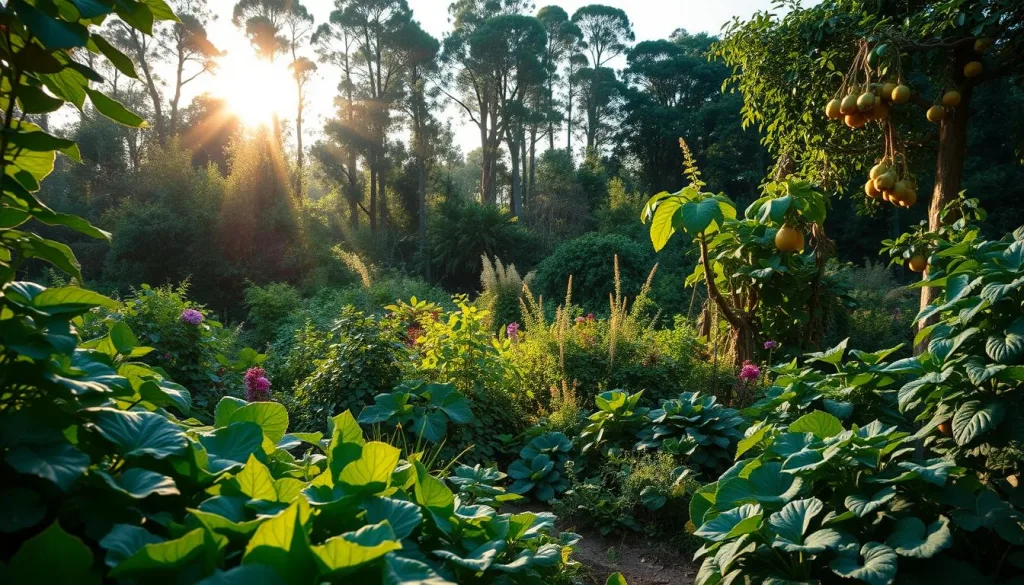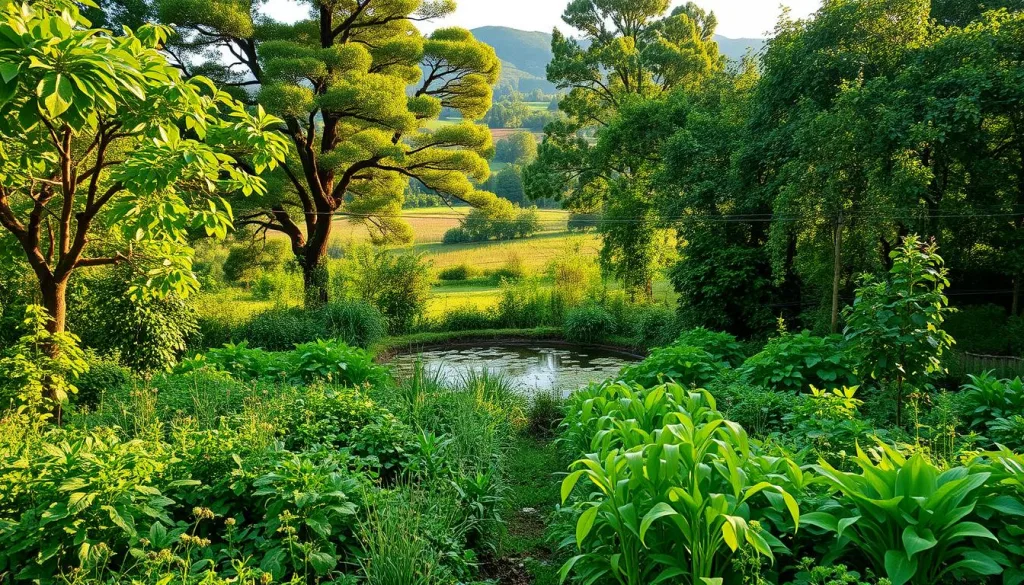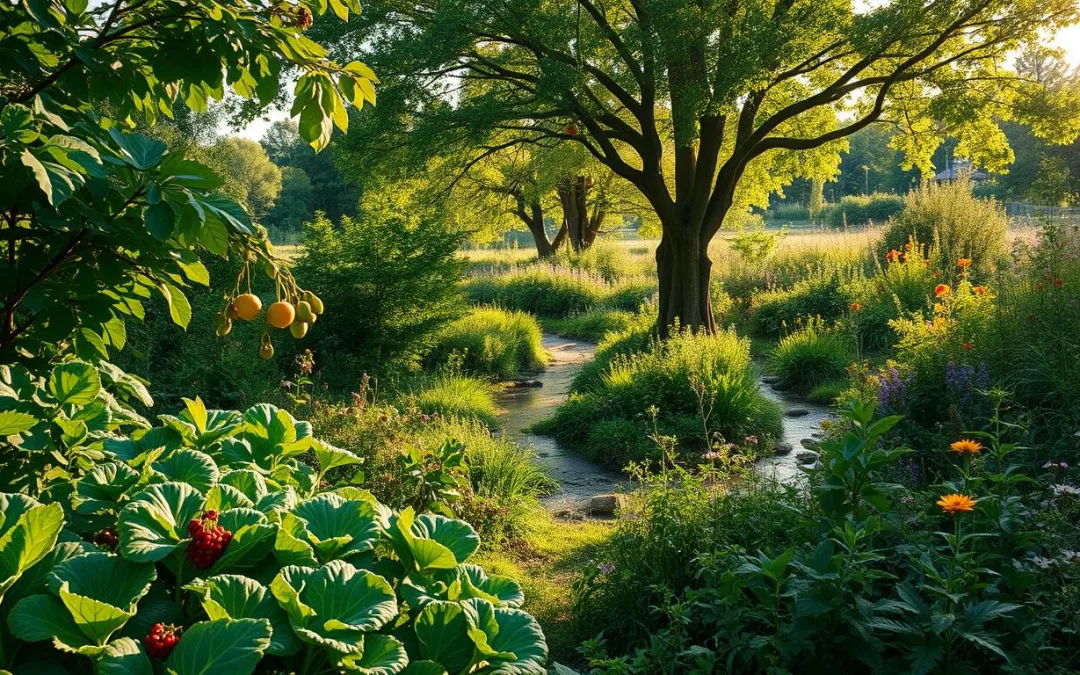Sustainable agriculture is changing how we grow food. Creating a sustainable food forest is a new way to farm that follows nature’s lead. With over 400,000 edible plants to choose from, it’s a great way to make small spaces productive.
Food forests are a new way to farm that works even in tiny spaces. You can grow a lot of food in just a few square feet. Plus, they help local wildlife by supporting biodiversity.
In the U.S., we throw away 92 billion pounds of food every year. Food forests are a better way to farm, cutting down on waste and making food systems stronger.
Key Takeaways
- Food forests can produce harvests with minimal maintenance
- Design can be adapted to various space constraints
- Supports local ecosystem and biodiversity
- Reduces food waste and promotes sustainable agriculture
- Potential to grow diverse edible plants in compact areas
Understanding Food Forest Systems and Their Benefits
Food forests are a new way to farm that’s good for the planet. They’re different from old farming methods. They create a complex, multi-layered system that works like a natural forest but gives lots of food.
What is a Food Forest?
A food forest is a new kind of farm that uses many plants together. It’s a self-sustaining landscape that can have up to 7 distinct layers. Each layer is important for the farm’s health and food production.
- Canopy trees provide structure and height
- Understory trees create mid-level diversity
- Shrubs and herbaceous plants fill intermediate spaces
- Ground covers protect soil and prevent erosion
Environmental and Social Benefits
Managing food forests is great for the environment and people. Studies show they can:
- Increase soil fertility by 30% within 3-5 years
- Support 50% more biodiversity compared to monoculture systems
- Potentially yield up to 10 times more produce per acre
- Provide resilient food sources in challenging environmental conditions
Sustainable Food Production Methods
Food forests are amazing at creating ecosystems that take care of themselves. They use plants that fix nitrogen and other smart combinations. This can cut down on the need for outside help by up to 50%. They’re a great answer to food security problems, helping both cities and rural areas get fresh food.
Food forests are not just gardens—they’re living, breathing ecosystems that nourish both people and the planet.
Creating a Sustainable Food Forest: Essential Planning Steps
Planning a sustainable food forest needs careful thought and strategy. Regenerative farming is key to a thriving ecosystem. It produces lots of food while keeping the environment healthy.
Start by doing a detailed site analysis. This means understanding your local landscape, microclimates, and natural patterns. Agroforestry systems suggest watching the land for a year. This helps you see seasonal changes, water flow, and existing plants.
Key Planning Considerations
- Evaluate sunlight exposure throughout different seasons
- Assess soil quality and drainage patterns
- Document existing plant and wildlife interactions
- Analyze water sources and possible irrigation methods
Success in your food forest depends on thorough preparation. Even small areas, like a few hundred square feet, can be productive. This is true if they are designed well.
| Planning Aspect | Recommended Approach |
|---|---|
| Site Selection | Observe for 12 months, track sunlight and water patterns |
| Soil Preparation | Test soil, add organic matter, boost fertility |
| Plant Diversity | Choose native species, aim for 100+ edible plant varieties |
Using smart regenerative farming techniques, you’ll build a strong, self-sustaining food forest. It can produce 10 times more food per square foot than regular gardens.
The Seven Layers of a Food Forest Ecosystem
Ecological food production through edible forest gardening is a new way to farm. It lets gardeners make a landscape that’s like a natural forest. This approach is good for the planet.
A food forest has seven layers, each with its own job. These layers work together to make a system that’s full of life and food. They help each other to grow well and keep the ecosystem balanced.
Canopy Layer: The Forest’s Backbone
The canopy layer is the base of the food forest. These tall trees are over 30 feet high. They do many things:
- They grow nuts and fruits
- They make shade for the lower layers
- They help fix nitrogen in the soil
Understory and Shrub Layers: Diverse Productivity
Below the canopy, smaller trees and shrubs grow. These layers add more food:
- Dwarf fruit trees
- Hazelnut bushes
- Serviceberry plants
Ground Covers and Root Systems
The bottom layers of a food forest are key too. Ground covers and root crops do important jobs:
| Layer | Functions | Example Plants |
|---|---|---|
| Ground Cover | Prevent weeds, keep moisture in | Strawberries, clover |
| Root Layer | Grow edible crops underground | Garlic, onions |
| Vine Layer | Use vertical space | Grapes, kiwifruit |
By planning these layers well, gardeners can make a system that feeds itself. Edible forest gardening is a complete way to farm that’s better for the earth than old ways.
Selecting the Perfect Location and Site Analysis
Choosing the right location is key for a successful food forest. The site you pick will affect your forest’s long-term health and success.
When looking at possible locations, keep these important points in mind:
- Sun exposure (minimum 6 hours of direct sunlight daily)
- Soil drainage capabilities
- Slope gradient (ideal 2-3%)
- Microclimate characteristics
- Proximity to water sources
Choosing the best site is more than just looking at the land. It’s about understanding how all parts of the ecosystem work together. Tools like Geographic Information Systems (GIS) can help you see the full picture of your land’s possibilities.
“A well-chosen site is half the success of your food forest project.” – Permaculture Design Expert
To do a thorough site analysis, follow these steps:
- Conduct soil testing at 15-30 cm depth
- Assess drainage capabilities
- Map microclimatic variations
- Evaluate existing vegetation
By carefully picking and analyzing your site, you’ll build a strong, thriving food forest. It will work well with the local environment.
Soil Preparation and Management Techniques
Starting a food forest means taking care of your soil. Organic management begins with good soil prep, the base of a healthy ecosystem. Regenerative farming shows how key soil health is for farming that lasts.
Soil Testing and Quality Improvement
For a food forest to thrive, you need to know your soil. A detailed soil test is a must. Good soil care can boost soil fertility by 40%, making plants healthier and more productive.
- Collect soil samples from different spots
- Check pH levels and nutrient levels
- Find out if there are mineral gaps
- See how much organic matter is there
Mulching and Composting Strategies
“Healthy soil is the heart of a productive food forest.”
Mulching and composting are key in regenerative farming. They make the soil better, add nutrients, and keep water in.
| Mulching Method | Benefits | Recommended Materials |
|---|---|---|
| Organic Mulch | Keeps moisture, controls temperature | Wood chips, straw, leaves |
| Compost Layering | Brings in nutrients, boosts microbes | Kitchen scraps, yard waste, manure |
| Green Manure | Fixes nitrogen, improves soil | Clover, legumes, cover crops |
Natural Fertilization Approaches
Organic food forest care means using natural fertilizers. This builds a soil ecosystem that grows plants naturally, without synthetic help.
- Add compost tea
- Use mycorrhizal inoculants
- Try crop rotation
- Include nitrogen-fixing plants
Plant Selection and Companion Planting Strategies

Creating a permaculture food forest needs careful plant selection and understanding of how plants interact. It’s not just about growing food. It’s about making a living, breathing ecosystem that helps plants grow well.
When planning your food forest, keep these key strategies in mind:
- Group nitrogen-fixing plants like sea buckthorn near fruit trees
- Incorporate plants that attract beneficial insects
- Use dynamic accumulators such as comfrey to enhance soil nutrition
- Create diverse planting schemes to improve natural pest resistance
Companion planting can boost crop yields by up to 20%. Traditional methods like the “three sisters” show how plants can help each other grow.
| Plant Combination | Benefits |
|---|---|
| Beans + Potatoes | Reduces Colorado potato beetle population |
| Radishes + Greens | Attracts and traps flea beetles |
| Corn + Beans + Squash | Mutually supportive growth and pest protection |
Pro tip: Rotate crops every 2-3 years to prevent disease buildup and maintain soil health.
“In nature, nothing exists alone.” – Ecology principle
Water Management and Irrigation Systems
Managing water well is key to a successful food forest. As water stress grows, new irrigation methods are vital for farming and land care.
By 2050, more than half the world will face water shortages. This shows how important it is to save water for farming.
Sustainable Watering Practices
Good water management needs a smart plan. Here are some important steps:
- Catch rainwater with smart landscape designs
- Use mulching to keep water from evaporating
- Choose plants that don’t need much water
- Make swales and areas to hold water
Drought-Resistant Design Tips
Building a tough food forest needs careful water planning. Different plants need different amounts of water, so a detailed plan is essential.
| Irrigation Method | Water Efficiency | Energy Productivity |
|---|---|---|
| Drip Irrigation | High (47.28 unit²) | Moderate |
| Sprinkler Irrigation | Moderate (23.98 unit²) | High |
| Furrow Irrigation | Low (21.44 unit²) | Low |
Using holistic land management keeps your food forest productive and saves water. Smart design makes your ecosystem strong and water-efficient, even in tough conditions.
Maintaining Biodiversity and Wildlife Integration

Creating strong agroforestry systems needs a deep understanding of biodiversity. Scientists say 8.7 million unique species exist, but industrial farming threatens this balance. By using edible forest gardening, we can make ecosystems that help wildlife and grow food.
Biodiversity is key for growing food in a sustainable way. Here are some important steps for better wildlife integration:
- Plant native species that attract pollinators
- Create diverse habitat zones within your food forest
- Integrate non-edible crops to support ecosystem health
- Design multilayered vegetation structures
Monarch butterfly numbers have dropped by 70 percent, showing we need wildlife-friendly farming. In edible forest gardening, we can make landscapes that offer shelter, food, and breeding places for many species.
Our agroforestry systems can be great for conservation. By copying natural patterns, we make places that help grow food and protect wildlife. Choosing plants wisely and designing habitats turns gardens into lively, connected networks.
Biodiversity is not just about survival—it’s about creating thriving, resilient ecosystems that sustain life in all its complexity.
Using these ideas means watching closely and adjusting as needed. Each food forest is a special place, showing the complex links between plants, animals, and their world.
Conclusion
Creating a sustainable food forest is a powerful way to change how we grow food. More people are interested in sustainable farming, which is great. Community food forests can produce up to 300% more food than traditional farms.
This method is more than just gardening. It’s a complete solution for growing food, saving the environment, and building strong communities.
Starting a food forest comes with its own set of challenges. It takes 7-8 years for a permaculture system to balance out. But the long-term gains are huge.
These systems help local wildlife, cool down cities, and offer a green alternative to regular farming.
Both city and country folks are seeing the value of food forests. Interest in urban farming and food forests has grown by about 30% in recent years. It’s not just a trend; it’s a key strategy for the future.
It helps with food security, protects the environment, and brings people together during uncertain times.
Looking ahead, food forests offer hope. They show us how careful planning and working with nature can change food production. This leads to systems that are good for both people and the planet.
FAQ
What exactly is a food forest?
How much land do I need to create a food forest?
What are the seven layers of a food forest?
How long does it take to establish a food forest?
What are the most important considerations for soil preparation?
How do I manage water in a food forest?
Can I create a food forest in any climate?
What are the main benefits of a food forest?
How do I choose plants for my food forest?
What is the role of biodiversity in a food forest?
Source Links
- Designing a Food Forest: Everything You Need to Know to Get Started – https://homesteadingfamily.com/designing-a-food-forest/
- How to Create a Food Forest—a Natural, Edible Landscape for Any Size Yard – https://www.marthastewart.com/how-to-grow-a-food-forest-7481752
- The Forested Garden: Understanding Food Forests and Their Benefits – https://foodforestabundancemn.com/the-forested-garden-understanding-food-forests-and-their-benefits/?srsltid=AfmBOoosMDj8batZgfiL8rLuHakhRRaC4mqKXkwzUntblcXYAYw9D3h3
- Food forests to feed the future – https://impact.economist.com/projects/foodsustainability/blogs/food-forests-to-feed-the-future/
- How to Build Your Own Food Forest – Stoney Creek Farm – https://stoneycreekfarmtennessee.com/how-to-build-your-own-food-forest/
- How To Create A Permaculture Food Forest, Forest Garden or Forest Farm | GroCycle – https://grocycle.com/how-to-create-a-food-forest/
- How To Grow A Food Forest – https://www.epicgardening.com/food-forest/
- The Seven-Layer Forest Garden:Designing A Food Forest – https://www.chelseagreen.com/2024/designing-a-forest-garden-the-seven-story-garden/?srsltid=AfmBOoqlTtaJBdYFW-WbUf2fP6HMb1iCUe6ddLOALkHqHqVAYpdrvqjk
- The Complete Guide to Food Forest Layers | GroCycle – https://grocycle.com/food-forest-layers/
- Advanced Permaculture Mapping: Design Your Food Forest – https://permaculturepractice.com/advanced-permaculture-mapping/
- Designing and Implementing a Permaculture Styled Food Forest in Your Backyard – https://www.halfacreintown.com/designing-and-implementing-a-permaculture-styled-food-forest-in-your-backyard/
- Designing a Thriving Forest Garden: A Step-by-Step Guide – Sustainable Life & Work – https://sustainablelifework.com/designing-a-thriving-forest-garden-a-step-by-step-guide/
- Creating A Sustainable Food Forest For The Whole Family – https://medium.com/@taimio/creating-a-sustainable-food-forest-for-the-whole-family-ff0f18e44d32
- Ecoversity | Design Your Own Permaculture Food Forest – https://www.ecoversity.org/permaculture-food-forest
- 9 Ways to Establish a Backyard Food Forest That Thrives Year-Round – FarmstandApp – https://www.farmstandapp.com/6816/establishing-a-backyard-food-forest/
- Green Mastery: Top 4 Ultimate Guide to Cultivating Permaculture Food Forests – Discover the World of Permaculture and Embrace Sustainability – https://thepermaculturechick.com/permaculture-food-forest/
- Companion planting made easy – https://runamukacres.com/companion-planting-made-easy/
- Field Guide: A Three-Tiered Approach to Increasing Sustainable Water and Food Security in the APEC Region – https://www.usda.gov/sites/default/files/documents/ppfs-field-guide-water-security.pdf
- Sustainable irrigation technologies: a water-energy-food (WEF) nexus perspective towards achieving more crop per drop per joule per hectare – https://pmc.ncbi.nlm.nih.gov/articles/PMC9254736/
- Creating a Sustainable Food Future: Interim Findings – https://www.wri.org/research/creating-sustainable-food-future-interim-findings
- Biodiversity and Agriculture – https://foodprint.org/issues/biodiversity-and-agriculture/
- Frontiers | Developing biodiversity-based solutions for sustainable food systems through transdisciplinary Sustainable Development Goals Labs (SDG-Labs) – https://www.frontiersin.org/journals/sustainable-food-systems/articles/10.3389/fsufs.2023.1144506/full
- How to Start a Food Forest – Step by step – https://www.thegreenlivingforum.net/forum/viewtopic.php?t=113663
- Greening the Future: Food Forest Design for Self-Sufficiency – https://foodforestabundancemn.com/greening-the-future-food-forest-design-for-self-sufficiency/?srsltid=AfmBOopSt5KZMuUzC4x9IxPjKj1Ua-_nCR7AKBzJoN96UQhcl7m1d3NX


